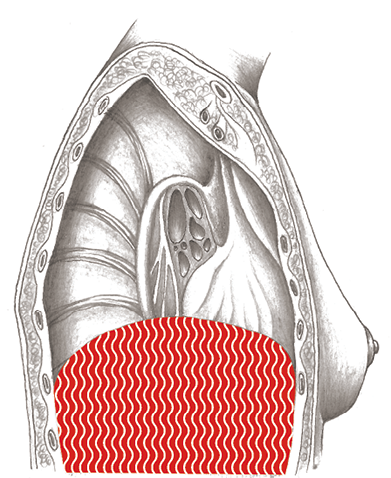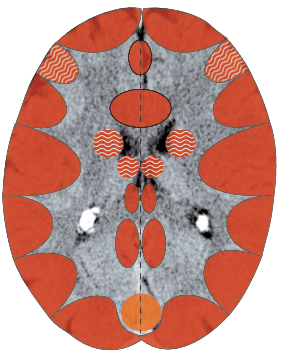 The information on this site is from one of the most famous books about the New Medicine (GNM / 5BN): "The Psychic Roots of Diseases" by Björn Eybl. Since September 2025, it is available in the form of an app with many additional features.
The information on this site is from one of the most famous books about the New Medicine (GNM / 5BN): "The Psychic Roots of Diseases" by Björn Eybl. Since September 2025, it is available in the form of an app with many additional features.It was written in german and was translated into more than 10 languages already. German is not freely available, as the rights are held by a publisher, but all these translations are available as ebooks / PDFs for free, as a gift of Björn for you, for the New Earth, for a new time.
In cooperation with Björn, it is splitted on "Disease is Different" into the sections by organ systems and combined with the real cases of our international testimonial / report archive of the related organ system.
DIAPHRAGM
The diaphragm is a 3-5 mm thick, dome-shaped sheet of striated muscle separating the chest cavity from the abdominal cavity.
Although the diaphragm is made up of purely voluntary (striated) muscle, it also receives impulses from the brainstem for the involuntary functioning of breathing and blood circulation (similar to the heart’s ventricles).
Functions of the diaphragm:
- As a breathing assistant, the diaphragm usually works involuntarily, but it can be tensed up voluntarily, for example, when taking deep breaths or holding one‘s breath.
- As an auxiliary muscle for blood circulation, the diaphragm operates entirely involuntarily. It supports the right heart chamber in aspirating venous blood from the body‘s circulatory system (= pressure-suction-pump). The left half of the diaphragm is more important for this. The right half of the diaphragm has only limited movement, possibly due to the liver, which is located directly under the diaphragm.
- We tense up the diaphragm voluntarily when giving birth, defecating or emptying the bladder = abdominal press.

Diaphragm coupled with
the Heart Muscle
Conflict of being overwhelmed
or outsmarted
Diaphragm independent of
the Heart Muscle
Not getting enough air,
not being able to inhale or exhale
SBS of the Diaphragm Muscles

Sleep apnea, diaphragm cramps
| Conflict | 1. Conflict of being overwhelmed: With this conflict, the diaphragm is functionally coupled with the heart muscle, i.e., the diaphragm reacts along with the heart (see: p.154). 2. Conflict for the diaphragm alone: not getting enough air, not being able to breathe and not being able to press out air, this also in a figurative sense: “It took my breath away.“ “It knocked the wind out of me.“ “I need to take a deep breath now.“ “I can’t breathe.” |
|---|---|
| Examples: |  A four-year-old boy falls from a bench while playing. Shocked, he begins to cry = conflict of not getting enough air. Throughout the following night and day, the patient comes into healing. As he is sleeping on the sofa, his parents notice he is turning blue = cessation of breathing due to a repair phase crisis of the diaphragm – diaphragm cramp. His left leg twitches and his whole body cramps up = repair phase crisis of a motor conflict due to falling from a bench. The next day, everything is all right again. (See www.germanische-heilkunde.at/index.php/erfahrungsberichte) A four-year-old boy falls from a bench while playing. Shocked, he begins to cry = conflict of not getting enough air. Throughout the following night and day, the patient comes into healing. As he is sleeping on the sofa, his parents notice he is turning blue = cessation of breathing due to a repair phase crisis of the diaphragm – diaphragm cramp. His left leg twitches and his whole body cramps up = repair phase crisis of a motor conflict due to falling from a bench. The next day, everything is all right again. (See www.germanische-heilkunde.at/index.php/erfahrungsberichte) A 53-year-old, right-handed patient, a kindergarten teacher, is married for the second time and has two children, aged 33 and 31. For 25 years, she has suffered from an unusual symptom, CM cannot understand it at all. Several times a week when resting, especially at night, she gets a violent cramp-like pain that goes through the abdomen into the thoracic spine. During these attacks, the patient must stand up in order to breathe reasonably. The patient also describes that she can’t urinate and defecate during and after the seizures, that she can’t build pressure in the abdomen. A 53-year-old, right-handed patient, a kindergarten teacher, is married for the second time and has two children, aged 33 and 31. For 25 years, she has suffered from an unusual symptom, CM cannot understand it at all. Several times a week when resting, especially at night, she gets a violent cramp-like pain that goes through the abdomen into the thoracic spine. During these attacks, the patient must stand up in order to breathe reasonably. The patient also describes that she can’t urinate and defecate during and after the seizures, that she can’t build pressure in the abdomen.Conflict history: The birth of her son is difficult, but thanks to an experienced doctor, everything goes well. During the press phase of her labor pains, she runs out of air – the doctor then kneels on her abdomen and presses the baby out – a healthy child is born. During the birth of her daughter, the scenario is similar: The last phase of labor is too weak to expel the baby. The child remains lodged in the birth canal. The patient is told to press harder but she is too weak and gives up: “I cannot press any more. I cannot push the baby out.“ > Conflict of not being able to push out the child. The patient wishes that the doctor from her first birth was there but he is not. An episiotomy is performed, albeit too late, and the baby is pulled out by force. The child is permanently handicapped. Six years later, as the mother learns to accept what has happened, the nightly epileptic, diaphragm cramp attacks begin. Whenever she sees her daughter, she thinks of the birth. Finally, after 25 years of suffering, a therapist who works with the 5 Biological Laws of Nature sees the causal relationship between the two. The birth is replayed as therapy: The therapist kneels on the patient‘s belly and imaginarily presses the child down and out. The patient‘s subconscious should now realize that “everything is all right now,“ especially since her now 31-year-old, slightly–handicapped daughter is the “apple of her eye.“ Guiding principle: “It‘s wonderful that I have such a sweet daughter. Everything is fine the way it is and the birth was fine.“ After the treatment, the patient has especially violent cramp attacks for 5 days = closing repair phase crisis during the repair phase. After that, she is released from her 25-year-long ordeal. (Archive B. Eybl) |
| Conflict-active | Conflict–active Paralysis, weakness, reduction of innervation or function > diaphragm elevation due to a lack of muscle tension. Weakness during physical exertions, because the diaphragm cannot help as much with breathing (most important muscle assisting breathing), pressing (lifting). Everything usually unnoticed. |
| Bio. function | Play-dead reflex. Predators lose interest when the prey doesn’t move or breathe. |
| Repair phase | Restoration of the nerve supply |
| Repair crisis | Epilepsy of the diaphragm = diaphragm cramp usually occurring at night or during periods of rest and piercing pain or twitching throughout the abdominal cavity. Due to the cramp in the diaphragm, breathing is restricted > acute shortness of breath, insufficient oxygen, turning blue (cyanosis). |
| Note | Through the functional coupling to the heart muscle (overwhelmed conflict), this may lead to sleep apnea or shortness of breath during the repair phase crisis of the heart muscle. This fact is confirmed by a French study, which installed pacemakers into apnea patients. The result was a surprising and serious improvement in symptoms in the group. (Source: N Engl J Med 346 2002 444) |
| Questions | First, determine if the heart is involved, which is usually the case: Cardiac arrhythmia without pain when relaxed? (Yes > heart SBS – overwhelmed conflict, see questions p. 155. No > diaphragm SBS alone). When did the symptoms begin? (Conflict shortly before). Did I have real problems with breathing, getting air or pressing out? In the figurative sense: What knocked the wind out of me? (A fright, unforeseeable stress, an argument)? Why couldn’t I deal with the situation? (Determine the core of the conflict). Were there similar situations in my childhood that conditioned me? (Question parents, awaken memories). Did my parents or ancestors experience anything similar? (Question parents and relatives). These types of conversations should be carried out with the express (inner) intention of bringing healing/love to the family. |
| Therapy | Should the cramps reappear, identify the conflict or tracks and resolve them. Find out where the love is – there you’ll find the solution. Breathing exercises, rhythmic sports (hiking, walking, cross-country skiing, dancing). See also heart-strengthening remedies p. 208. |
Hiccups (singultus)
Same SBS as above (ee: p.256). Hiccups are a sudden and uncoordinated tensing of the diaphragm.
The unexpected rush of air through the pharynx causes the glottis to close with the resulting “hiccup.“
| Examples | ➜ Someone drinks so greedily that he “forgets“ to breathe, causing an oxygen insufficiency. ➜ Someone talks to his sports buddy, while they are running = conflict of not getting enough air.  The 47-year-old woman is planning a big celebration with relatives for her father‘s 80th birthday. She needs to coordinate everything with her two siblings, which costs her a lot of effort and nerves. Finally, everything is settled and she is looking forward to the party, which is to occur in 6 weeks. One day, the patient phones her father. In passing, he mentions that he doesn‘t want a party and that it shouldn‘t take place. The patient is completely taken aback – her breath is taken away (= conflict). Fortunately, she immediately has a heart-to-heart talk with her partner about the matter. Half an hour later, as the two laugh about the stubborn old man, the woman gets a case of the hiccups, stronger than she has ever had before. (Archive B. Eybl) The 47-year-old woman is planning a big celebration with relatives for her father‘s 80th birthday. She needs to coordinate everything with her two siblings, which costs her a lot of effort and nerves. Finally, everything is settled and she is looking forward to the party, which is to occur in 6 weeks. One day, the patient phones her father. In passing, he mentions that he doesn‘t want a party and that it shouldn‘t take place. The patient is completely taken aback – her breath is taken away (= conflict). Fortunately, she immediately has a heart-to-heart talk with her partner about the matter. Half an hour later, as the two laugh about the stubborn old man, the woman gets a case of the hiccups, stronger than she has ever had before. (Archive B. Eybl) |
|---|---|
| Phase | Repair phase crisis in the context of the repair phase – diaphragm cramp = hiccups. |
| Therapy | Identify the conflict and conditioning and, if possible, resolve them in real life should they reoccur. Questions: see above. Breathe in deeply several times and hold the breath (hyperventilation) or cough, in order to bring the hiccups into “the right rhythm“ again. Swallow a teaspoon of cumin seeds with water. Drink several sips of cold water, or lemon water or take a spoonful of sugar. Inhale with stimulating etheric oils (camphor, peppermint, etc.). These measures bring about a vegetative changeover, a “reboot“ for the diaphragm contractions. |
Side stitches
| Example | ➜ Someone eats a meal just before playing a sport. |
|---|---|
| Phase | Repair phase crisis in the context of the repair phase – diaphragm cramps = side stitches. |
| Note | The main trigger is eating before physical exercise. Since the stomach and intestines are partly anchored to the diaphragm, the diaphragm is pulled down by full visceral organs > limitation of the diaphragm‘s breathing assistance mechanism > start of an SBS of the diaphragm. People, who have weak muscles and weak connective tissue, probably also have a weak diaphragm, which soon reaches its performance limits. |
| Therapy | Identify the conflict and conditioning and, if possible, resolve them in real life, should they reoccur. Questions: see above. Strength training, especially for the muscles of the trunk of the body. Pay attention to posture and body tension. Breathing exercises (possibly in the form of yoga) or alternative respiration. Do not eat before sport sessions. During sport sessions, breathe deeply and calmly. Do not talk. |
Diaphragmatic hernia, hiatus hernia
Same SBS as above (see: p.256) – hard to distinguish from an injury, accident. Due to a hole in the diaphragm, the stomach, intestines or other abdominal organs can protrude into the chest cavity.
The most frequently affected organ is the stomach (hiatus hernia).
| Phase | Conflict–active phase: reduction of transverse muscle fibers > thinning of the diaphragm > tendency for hernia, for instance, when lifting heavy objects or doing “crunches.“ |
|---|---|
| Therapy | Determine the conflict and conditioning and, if possible, resolve them in real life should they still be active. Questions: see previous page. Breathing training (possibly yoga); strength training, especially for the trunk of the body, surgery if necessary. |
Testimonials
All experience reports on the organ system « Diaphragm » from the International Report Archive:
| Author | Title and Overview | Keywords | ||||
|---|---|---|---|---|---|---|
 | 2021/07/23    After reading two detailed books, a double volume, I tried to analyze a symptom that had been recurring and disappearing regularly for decades. Parallel to this symptom, which was described separately, a respiratory impairment from the diaphragm program occurred again and again. The epileptoid crisis in the regeneration phase of this program was well endured - with the knowledge of the 5 Biological Laws of Nature: With this understanding, the necessary calmness and composure could be maintained. | diaphragmatic spasm |
